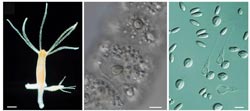Deadly Jellyfish Weapons Unravelled

Hydra freshwater polyp. Animal with tentacles and buds (left); tentacle with nematocysts in battery cells of a tentacle (middle); isolated and partly discharged stinging capsules (right)<br><br>Photos: Nüchter and Holstein (left), Holstein (middle and right), Molecular Evolution & Genomics, COS Heidelberg<br>
Heidelberg researchers have succeeded in unravelling the defence mechanisms of jellyfish. Scientists working with Prof. Dr. Thomas Holstein and Dr. Suat Özbek from the Centre for Organismal Studies (COS) of Heidelberg University, together with collaborators from the German Cancer Research Center (DKFZ), analysed the proteome, or full set of proteins, of the stinging cells in the freshwater polyp Hydra.
The results of their research reveal a complex mixture of toxic and structural proteins that can explain the extraordinary toxicity and biophysical properties of these unique cells. They also show how the energy for discharging the toxin can be stored in the stinging cells and released at extraordinary speed.
With their poison cells, jellyfish and other cnidarians have developed one of the most venomous and differentiated cellular mechanisms in the animal kingdom. Stinging cells, also known as nematocysts or cnidocysts, are found in the outer cell layer of cnidarians and are used for capturing prey or for defence. They consist mainly of a stinging capsule, a giant secretory vesicle. Inside this organelle a long, barbed tubule is coiled up, which turns inside out like the finger of a glove during discharge, thus releasing the deadly poison into the prey. This mixture of previously unknown toxins paralyses the nervous system of the prey and destroys their cells. Injecting the toxins requires an effective mechanism. Studies have shown that the discharge of toxins is associated with an extremely high pressure of 15 megapascals, whereby the stylet, a thin barb, is able to penetrate even thick crustacean shells. The stylet is accelerated at a force of 5 million g in under 700 nanoseconds, making the discharge of toxins harpoon-like.
Up until now, the molecular components responsible for the biomechanical properties of these unique cellular weapons were largely unknown. The Heidelberg scientists used protein mass spectroscopy to study the cells of the Hydra magnipapillata freshwater polyp. The procedure afforded them a precise qualitative and quantitative analysis of the chemical composition of the substances, thus enabling them to map the nematocyst proteome of the Hydra. Prof. Holstein and Dr. Özbek’s research team were surprised at its complexity. The biologists discovered 410 proteins with venomous and lytic, but also adhesive or fibrous properties. The proteins of the stinging capsule wall contain hitherto unknown structural components that form a tissue-like matrix, a complex protein mesh. This structure of collagen and elastomers surpasses the elasticity and tensile strength of even spider’s silk.
These findings allow the Heidelberg researchers to explain how the energy for discharging the toxin can be stored in the stinging cells and then released from the elastic structure of the capsule wall in nanoseconds at an extraordinary speed. “The poison cells of the cnidarians represent an effective combination of the powerful molecular spring mechanism and a structure with extreme biophysical properties,” says Prof. Holstein. The studies also suggest that the organelles containing the injectable toxin have adopted the molecular properties of connective tissue proteins such as collagens during their development. According to Prof. Holstein, it was an unexpected solution in early evolution to develop such a sophisticated mechanism for prey capture and defence.
Original publication:
Prakash G. Balasubramanian, Anna Beckmann, Uwe Warnken, Martina Schnölzer, Andreas Schüler, Erich Bornberg-Bauer, Thomas W. Holstein, and Suat Özbek: Proteome of Hydra Nematocyst, Journal of Biological Chemistry, 23 March, 2012, doi:10.1074/jbc.M111.328203
Contact:
Prof. Dr. Thomas Holstein / PD Dr. Suat Özbek
Centre for Organismal Studies
Phone +49 6221 54-5679, -5638
thomas.holstein@cos.uni-heidelberg.de
suat.oezbek@cos.uni-heidelberg.de
Communications and Marketing
Press Office, phone: +49 6221 54-2311
presse@rektorat.uni-heidelberg.de
Media Contact
More Information:
http://www.uni-heidelberg.deAll latest news from the category: Life Sciences and Chemistry
Articles and reports from the Life Sciences and chemistry area deal with applied and basic research into modern biology, chemistry and human medicine.
Valuable information can be found on a range of life sciences fields including bacteriology, biochemistry, bionics, bioinformatics, biophysics, biotechnology, genetics, geobotany, human biology, marine biology, microbiology, molecular biology, cellular biology, zoology, bioinorganic chemistry, microchemistry and environmental chemistry.
Newest articles

Bringing bio-inspired robots to life
Nebraska researcher Eric Markvicka gets NSF CAREER Award to pursue manufacture of novel materials for soft robotics and stretchable electronics. Engineers are increasingly eager to develop robots that mimic the…

Bella moths use poison to attract mates
Scientists are closer to finding out how. Pyrrolizidine alkaloids are as bitter and toxic as they are hard to pronounce. They’re produced by several different types of plants and are…

AI tool creates ‘synthetic’ images of cells
…for enhanced microscopy analysis. Observing individual cells through microscopes can reveal a range of important cell biological phenomena that frequently play a role in human diseases, but the process of…





















